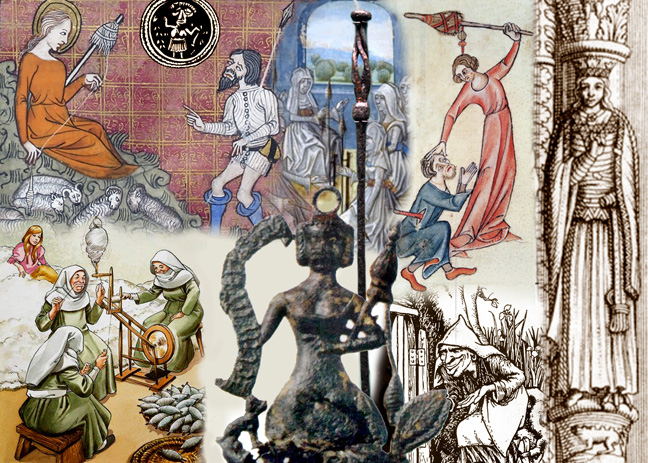The Distaff: Fates, Fatas, and Women's Power

The distaff has been a symbol of female power for millennia. European cultures associated it with goddesses, fatas and faeries, saints and witches. The goddesses depicted with this female spinning wand include Athena, the Parcae, Gaulish and British goddesses and, among the Franks, Berthe Pédauque and Mother Earth. The English expression "the distaff side" refers to matrilineage.
Rich folk traditions tell of women's offerings to faery godmothers; Habetrot (England), Lughia Rajosa (Sardinia) and Paraskeva L'nyanitsa (Russia). Scandinavian archaeology has revealed a pattern of völur (seeresses) buried with shamanic staffs, many of them shaped like distaffs. This discovery links the Norse völur with the rich mythology of spinning Fates, and with women's ceremony in broader European folk religions. Like the völur, witches were closely associated with the distaff, with its strong aura of female sovereignty, even as its potency was demonized in the witch hunts.
Medieval miniatures of women jousting with distaffs against men also depicted female rebellion. By the 1400s, artists had consolidated a somewhat humorous "battle of the sexes" motif into a virulently misogynist theme of the Emasculating Distaff, in which women assert rulership over men by beating them with distaffs. Or men are forced to carry distaffs, as in the Skimminton and charivari processions that ridiculed non-dominating husbands.
Yet the Old Spinner survived in the French "Tales of My Mother Goose," the British women's holiday St. Distaff's Day, and in the goddesses and cosmological symbols carved into Russian and Lithuanian distaffs.
90 minute visual presentation. Requires digital projector with VGA cable for connection.
Suppressed Histories Archives | Articles | Max Dashu